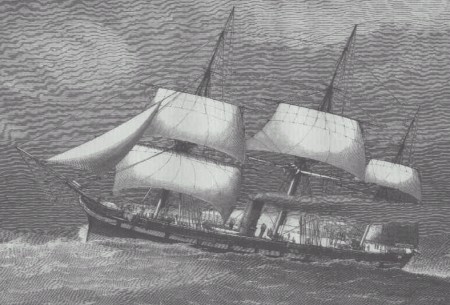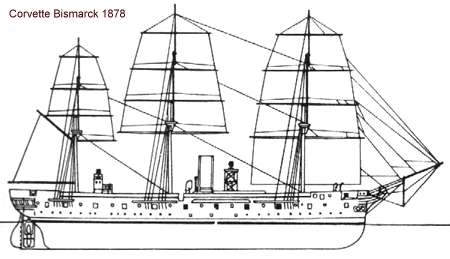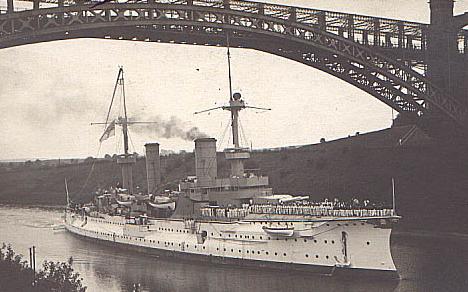
SHIPS NAMED BISMARCK
 The corvette Bismarck.
The corvette Bismarck.
The battleship Bismarck was the fourth ship of the German Navy named after the German Chancellor, and also the last since the name Bismarck has not been used again by any German ship.1)
The battleship Bismarck predecessors were:
The Corvette Bismarck.
The corvette Bismarck, the first ship to wear the name, was built by Norddeutsche Schiff AG in Kiel.
She was launched on 25 July 1877 and commissioned on 27 August 1878.
The Bismarck served in the colonial fleet in the South Seas for 10 years from 1878 to 1888, and represented the German Navy at the 1880 world's fair in Australia while disabled and in for repairs.
Reinhard Scheer (later Admiral and commander of the German High Seas Fleet) served aboard this ship when a young officer.
She had four sister ships: Stosch, Gneisenau, Moltke and Stein, which also served mostly abroad.
On 27 September 1891, the corvette Bismarck was stricken and then reduced to a barrack hulk at Wilhelmshaven.
She was broken up in 1920 at Rüstringen.
Displacement: 3,386 mt. max.
Dimensions: overall length 82.50 m, water line 72.20 m, beam 13,7 m, draft 5.68 m forward, 6.18 m aft.
Armament: 16 x 15cm/22, 2 x 8.8cm/30, 2 x 8.8cm/30, 6 x machine guns, 2 x 35cm TT, bow.
Propulsion Plant: One horizontal 3-cylinder single expansion engine, four transverse trunk boilers, one retractable 2-bladed screw of 5.2m diameter, one generator 1.9kW 55V. Power 2530 ihp max.
Speed: 12.5 knots max.
Crew: 404 men.

The Armoured Cruiser Fürst Bismarck.
This cruiser was laid down on 1 April 1896 at the Kaiserliche-Werft in Kiel.
She was launched on 25 September 1897 and later commissioned on 1 April 1900.
The Fürst Bismarck served abroad in the East-Asian Squadron until 1909.
Between 1910 and 1914 she was refitted at Kiel Dockyard and used as a coastal defence ship.
In March 1915, the ship was disarmed and converted to an engine training ship.
In 1919 she was used as an naval office ship until she was stricken on 17th June and sold to Brand & Son, Audorf.
She was scrapped in 1919-20 at Audorf-Rendsburg.
Displacement: standard 10,690 mt, full load 11,460 mt.
Dimensions: overall length 127 meters, water line 125.7 meters, beam 20.4 meters, draft 7.8 meters forward, 8.46 aft.
Armament: 4 x 24cm/L40, 12 x 15cm/L40, 10 x 8.8cm/L30, 5 x 45cm TT.
Protection: deck 30-50 mm, belt 100-200mm, main turrets 200 mm max, conning tower 200 mm max.
Propulsion Plant: Three vertical 4-cylinder engines, 8 Dürr burners boilers, three screws, power 13,622ihp max.
Speed: 18.7 knots.
Crew: 621 men.
 The armoured cruiser Fürst Bismarck.
The armoured cruiser Fürst Bismarck.
Battlecruiser Fürst Bismarck.
This warship was laid down on 3 November 1915 at Wilhelmshaven as Ersatz A (Replacement A) and the proposed name was Fürst Bismarck.
She was to have been a 31,000-ton battlecruiser of the Mackensen class, but it was never launched, and about 26 months before completion, the ship was stricken on 17 November 1918 and broken up in 1922.
Displacement: standard 31,000 mt, full load 35,300 mt.
Dimensions: overall length 223 meters, beam 30.4 meters, draft 9.3 meters forward, 8.4 aft.
Armament: 8 x 35cm/45, 14 x 15cm/45, 8 x 8.8cm/45, 5 x 60cm TT.
Protection: deck 30 mm, belt 300 mm, main turrets 320 mm max, conning tower 350 mm max.
Propulsion Plant: Four sets of turbines with Föltinger fluid transmission, 24+8 boilers, 8 diesel generators 2,320kW 220V, four 3-bladed screws, power 90,000shp. Two rudders.
Speed: 28 knots.
Crew: 1,186 men.
1) There were other ships named Bismarck such as the liners of the Hamburg-American Line which are not included here.
|




